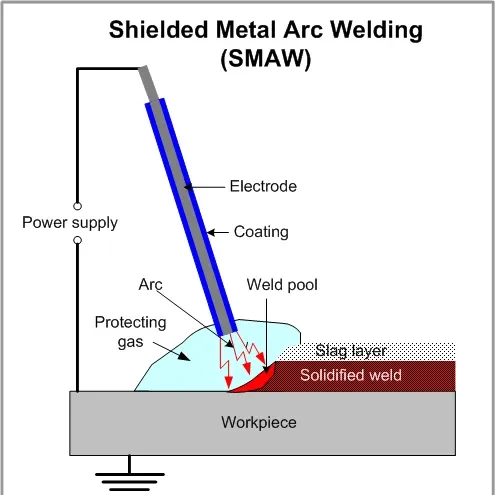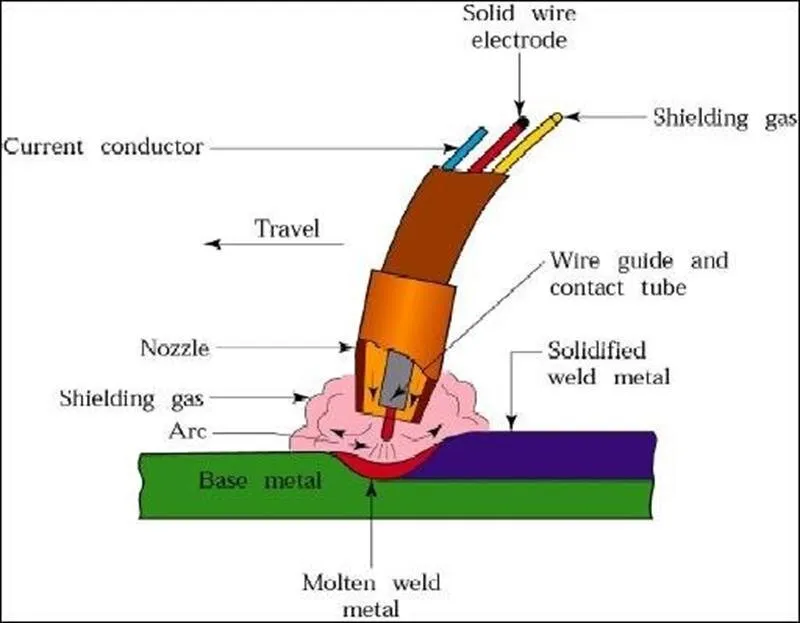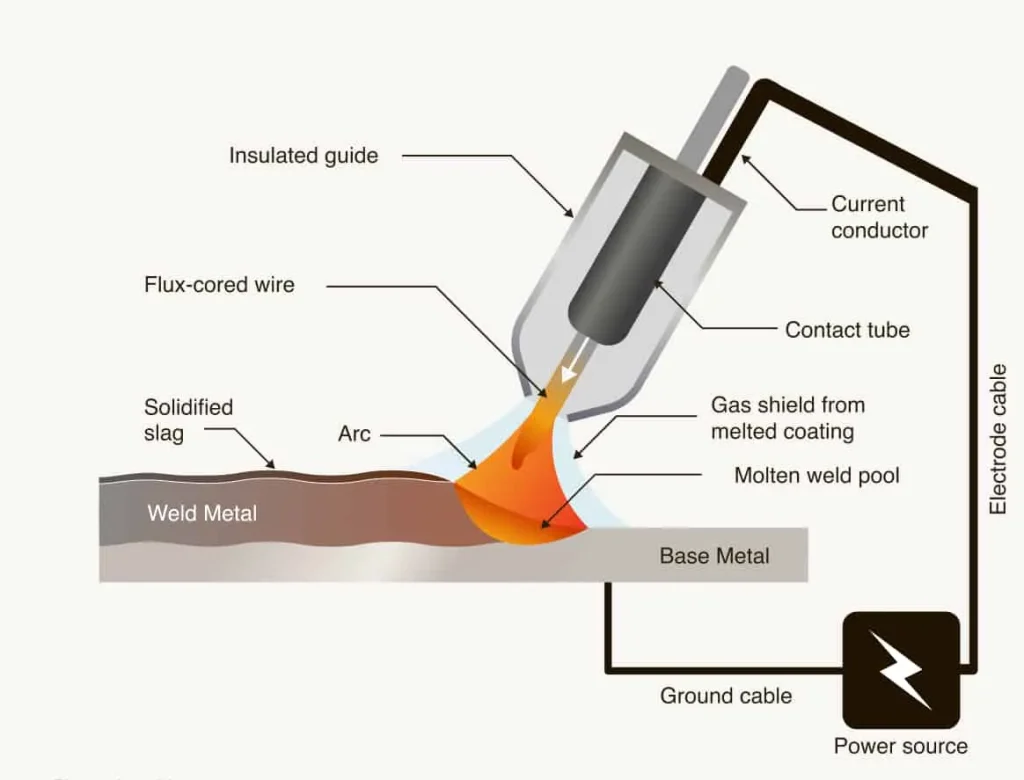Introduction to Arc Welding
Arc welding is a process that uses an electric arc to join metals by melting them at the welding point. This method is widely used in various industries due to its effectiveness and versatility. The electric arc is created between an electrode and the base material, generating intense heat that melts the metals and allows them to fuse together upon cooling.
The history of arc welding dates back to the late 19th and early 20th centuries. The process was first demonstrated by Russian inventor Nikolai Benardos in 1881, and later improved by several inventors including C.L. Coffin, who developed the coated electrode in 1907. These early advancements laid the foundation for modern arc welding techniques.
In today’s industrial landscape, arc welding plays a crucial role. It is essential in the construction of buildings, bridges, and other infrastructure, as well as in the manufacturing and repair of vehicles, ships, and machinery. Its ability to create strong, durable joints makes it indispensable in sectors where structural integrity is paramount.
Operating Principle
The operating principle of arc welding revolves around the formation of an electric arc between an electrode and the workpiece. When an electric current is passed through the electrode, it creates a sustained arc that produces a temperature of around 6,500°F (3,600°C). This high temperature is sufficient to melt most metals, allowing the molten metal from the electrode and the workpiece to mix and form a strong bond upon cooling.
There are two main types of electrodes used in arc welding: consumable and non-consumable. Consumable electrodes, such as those used in Shielded Metal Arc Welding (SMAW) and Gas Metal Arc Welding (GMAW), melt and become part of the weld joint. Non-consumable electrodes, like those used in Gas Tungsten Arc Welding (GTAW), do not melt; instead, they provide a stable arc while a separate filler material is used to create the weld.
The arc welding process involves several steps:
- Striking the arc: This can be done by touching the electrode to the workpiece and then quickly pulling it away to establish the arc.
- Maintaining the arc: The welder must maintain a consistent distance between the electrode and the workpiece to keep the arc stable.
- Moving the electrode: The welder moves the electrode along the joint to ensure even heating and fusion of the metals.
- Cooling: Once the weld is complete, the molten metal cools and solidifies, forming a strong joint.
Common Types of Arc Welding
Shielded Metal Arc Welding (SMAW)

- Process Description: Also known as stick welding, SMAW uses a consumable electrode coated with flux to lay the weld. The flux coating disintegrates during welding, releasing vapors that serve as a shielding gas and creating a slag layer to protect the weld from contaminants.
- Common Uses: SMAW is widely used for its simplicity and effectiveness in various applications, including construction, shipbuilding, and repair work. It is particularly useful for welding iron and steel.
Gas Metal Arc Welding (GMAW)

- Process Description: GMAW, commonly referred to as MIG (Metal Inert Gas) welding, uses a continuously fed wire electrode and a shielding gas to protect the weld pool. The process is semi-automatic or automatic, allowing for high production rates and ease of use.
- Common Uses: GMAW is commonly used in the automotive industry, manufacturing, and for welding aluminum and other non-ferrous metals.
Gas Tungsten Arc Welding (GTAW)

- Process Description: Also known as TIG (Tungsten Inert Gas) welding, GTAW employs a non-consumable tungsten electrode to produce the weld. The weld area is protected from atmospheric contamination by an inert shielding gas, usually argon or helium.
- Common Uses: GTAW is preferred for its precision and control, making it ideal for welding thin sections of stainless steel, aluminum, magnesium, and other non-ferrous metals. It is extensively used in aerospace, automotive, and art metalwork.
Flux-Cored Arc Welding (FCAW)

- Process Description: FCAW uses a continuous tubular wire filled with flux. It can be self-shielded, where the flux generates the necessary protective gases, or dual-shielded, where an external shielding gas is also used.
- Common Uses: FCAW is known for its high welding speed and portability, making it suitable for heavy steel construction, shipbuilding, and outdoor welding applications.
Advantages and Disadvantages of Arc Welding
Advantages
- Low Cost: Arc welding equipment and consumables are generally affordable, making it a cost-effective option for many applications.
- Flexibility: Arc welding can be used to join a wide variety of metals and alloys in different thicknesses and positions.
- Suitability for Various Metals: The process is versatile and can be adapted to weld different types of metals, including steel, stainless steel, aluminum, and cast iron.
Disadvantages
- Requires High Skill: Proper technique and training are necessary to achieve high-quality welds. Inexperienced welders may produce weak or defective welds.
- Potential Dangers: Arc welding involves high temperatures and electrical currents, posing risks of burns, electric shock, and exposure to harmful fumes if not performed correctly with appropriate safety measures.
Applications of Arc Welding
Construction Industry
- Steel Structures: Arc welding is widely used in the construction of steel structures such as buildings, bridges, and towers. Its ability to create strong and durable joints makes it ideal for structural applications where safety and longevity are critical.
- Infrastructure: Beyond buildings and bridges, arc welding is essential in constructing various infrastructures like pipelines, railways, and heavy machinery, ensuring that these structures can withstand heavy loads and harsh environmental conditions.
Automotive Industry
- Vehicle Manufacturing: Arc welding is employed in the manufacturing of automobiles, trucks, and other vehicles. It is used to join various metal parts of the vehicle’s frame, body, and engine components, providing strength and reliability.
- Repairs and Maintenance: The flexibility and portability of arc welding make it suitable for on-site repairs and maintenance of vehicles, ensuring that damaged or worn parts can be effectively repaired or replaced.
Shipbuilding Industry
- Hull Construction: The shipbuilding industry relies heavily on arc welding for constructing ship hulls and other critical components. The process ensures watertight and robust joints necessary for the integrity and safety of the vessel.
- Offshore Structures: In addition to ships, arc welding is used in building offshore structures like oil rigs and platforms, which require strong and corrosion-resistant welds to withstand the harsh marine environment.
Industrial Equipment Production and Repair
- Manufacturing Equipment: Arc welding is integral in manufacturing industrial equipment and machinery. It is used to fabricate and assemble various parts and components, ensuring they can handle rigorous industrial operations.
- Maintenance and Overhaul: Arc welding is also crucial for maintaining and overhauling industrial equipment. It allows for the repair and reinforcement of worn or damaged parts, extending the lifespan of the equipment.
Safety in Arc Welding
Personal Protective Equipment (PPE)
- Welding Helmet: A welding helmet with a proper shade lens is essential to protect the eyes and face from the intense light and radiation produced by the arc. Auto-darkening helmets are often preferred for their convenience and protection.
- Gloves and Clothing: Heat-resistant gloves and protective clothing made from fire-resistant materials like leather are necessary to protect the hands and body from sparks, spatter, and heat.
- Foot Protection: Sturdy, heat-resistant boots protect the feet from falling metal and sparks.
Safety Procedures
- Fire Prevention: Clear the welding area of flammable materials and keep fire extinguishers nearby. Use fire-resistant blankets and curtains to contain sparks and spatter.
- Proper Ventilation: Ensure adequate ventilation or use fume extraction systems to remove hazardous fumes and gases produced during welding. This is particularly important in confined spaces.
- Electrical Safety: Regularly inspect welding equipment and cables for damage. Use properly grounded equipment to prevent electrical shocks.
Importance of Ventilation and Eye Protection
- Ventilation: Proper ventilation helps to disperse harmful fumes and gases, protecting the welder and others in the vicinity from inhaling toxic substances. This can be achieved through natural ventilation, local exhaust ventilation, or general mechanical ventilation.
- Eye Protection: In addition to the welding helmet, safety glasses or goggles should be worn underneath to protect the eyes from flying debris and sparks. Eye protection is critical to prevent injuries that could result in permanent vision loss.
Reference Materials and Training
Educational Materials
- Books and Manuals: Numerous books and manuals provide in-depth knowledge on arc welding techniques, safety practices, and equipment. These resources are valuable for both beginners and experienced welders seeking to enhance their skills.
- Online Resources: Websites, online courses, and video tutorials offer accessible and comprehensive information on various aspects of arc welding. These resources are convenient for self-paced learning and keeping up with the latest advancements.
Training Courses
- Vocational Schools: Many vocational schools and technical institutes offer specialized training programs in arc welding. These programs cover theoretical knowledge and hands-on practice, preparing students for careers in welding.
- Apprenticeships: Apprenticeship programs provide on-the-job training under the supervision of experienced welders. Apprentices gain practical skills and industry experience, often leading to certification and employment opportunities.
Certification and Professional Training
- Certification Bodies: Organizations such as the American Welding Society (AWS) and the International Institute of Welding (IIW) offer certification programs that validate a welder’s skills and knowledge. Certification can enhance career prospects and credibility in the industry.
- Continued Education: Many professionals pursue continued education and advanced training to stay current with technological advancements and industry standards. Workshops, seminars, and advanced courses are available for those seeking to specialize in specific welding techniques or applications.
New Technologies and Innovations in Arc Welding
Technological Advancements
- Advanced Welding Machines: Modern arc welding machines come equipped with digital controls, automated settings, and advanced monitoring systems. These features improve precision, efficiency, and ease of use, reducing the likelihood of errors.
- Welding Consumables: Innovations in electrode and filler material technology enhance weld quality and performance. New coatings and compositions provide better arc stability, reduced spatter, and improved mechanical properties of the weld.
Automation in Arc Welding
- Robotic Welding Systems: Automation in arc welding is becoming increasingly prevalent, with robotic welding systems being used for repetitive and high-volume tasks. These systems offer consistent quality, increased productivity, and reduced labor costs.
- Computer-Aided Welding: Integration of computer-aided design (CAD) and manufacturing (CAM) systems with welding equipment allows for precise control and customization of the welding process. This results in higher accuracy and efficiency.
Use of Robotics in Welding Processes
- Collaborative Robots (Cobots): Collaborative robots, or cobots, work alongside human welders, assisting with tasks such as positioning, holding, and guiding. Cobots enhance productivity and safety by reducing the physical strain on welders.
- Artificial Intelligence (AI) and Machine Learning: AI and machine learning technologies are being applied to welding processes to optimize parameters, predict defects, and improve overall weld quality. These technologies enable adaptive welding systems that can learn and adjust in real-time.
Conclusion
Arc welding remains a fundamental technique in various industries, offering reliable and versatile solutions for joining metals. With ongoing advancements in technology, safety, and training, arc welding continues to evolve, ensuring its relevance and effectiveness in meeting the demands of modern manufacturing and construction. The future of arc welding looks promising, with innovations poised to enhance efficiency, quality, and safety in welding processes.
Leave a Reply